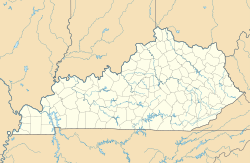Louisville Free Public Library, Western Colored Branch
|
Louisville Free Public Library, Western Colored Branch
|
|

Front of the library
|
|
| Location | 604 S. 10th St., Louisville, Kentucky |
|---|---|
| Coordinates | 38°14′59″N 85°46′3″W / 38.24972°N 85.76750°WCoordinates: 38°14′59″N 85°46′3″W / 38.24972°N 85.76750°W |
| Area | less than one acre |
| Built | 1907 |
| Architect | McDonald & Dodd; Lortz & Frey Planing Mill Co. |
| Architectural style | Beaux Arts |
| NRHP Reference # | 75000771 |
| Added to NRHP | December 6, 1975 |
The Louisville Free Public Library, Western Colored Branch is a Carnegie library, the first public library built for African-Americans. Also known as Louisville Free Public Library, Western Branch, it is a branch of the Louisville Free Public Library system.
The Western Colored Branch library first opened in September 1905 and was originally located at 1125 West Chestnut Street. At the time it was common for black libraries to be housed in rented or converted private facilities; when the Western Colored Branch first opened it was operated in three rented rooms in a private home.
Albert Ernest Meyzeek, principal of Central High School at the time, was concerned about the lack of adequate reading and reference materials at the school. He challenged the 1902 legislation that created the Louisville Free Public Library system, on the basis that it did not adequately serve African Americans, and persuaded the city council to open a branch to fill this need. Meyzeek later pushed for a second black library, the Eastern Colored Branch (which opened in 1914).
In 1908, industrialist Andrew Carnegie donated funds to build a new library building. As a result, the Western Colored Branch became the first public library for African Americans in the American South that was housed in a Carnegie-funded facility. The new library building was designed by McDonald & Dodd.
The library was well received by the community. It marked a new level of civic engagement by "the emerging, turn-of-the-century, southern black middle class" which was determined to "build positive community infrastuctures for purposes of racial uplift."
Several prominent African-American librarians worked in the Western Branch and assisted in education and outreach programs for the local black community. Of particular note are Reverend Thomas Fountain Blue, who served as the administrative head of the Western and Eastern Colored Branches as well as Rachel Davis Harris, who served as the children's library specialist and chief assistant. Blue and Harris were influential in providing services to Louisville's African American community during the Jim Crow era. In 1917, about 12,000 people attended 498 meetings at both branches. The two branches (Western and Eastern) became community social centers and regional models for other libraries like it.
...
Wikipedia


